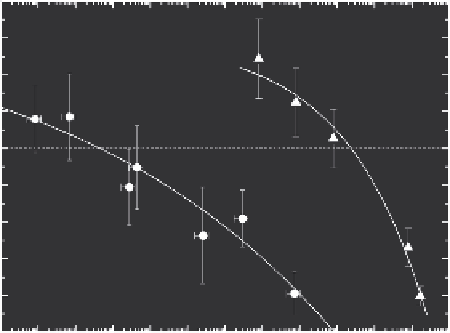Environmental Engineering Reference
In-Depth Information
1.8
1.6
1.4
24 nm
Peroral
1.2
37 nm
1.0
25 nm
77 nm
0.8
0.6
32 nm
0.4
93 nm
85 nm
Aerosol treatment
0.2
0.0
10
-9
10
-8
10
-7
10
-6
10
-5
10
-4
10
-3
10
-2
10
-1
10
0
10
1
10
2
10
3
Lung or orally deposited dose (mg/kg)
FIGURE 11.10
RAI (the ratio between the mean number of writhes for the aerosolized group and that for
untreated group) versus the lung-deposited dose (circles). Triangles are RAI values for peroral treatment. Bars
indicate standard error. The itted dose-response curves are shown as solid lines. Mean particle diameter is
indicated for each inhalation point.
and 37 nm, respectively, in these experiments which corresponded to the average lung-deposited
dose of 1.4 × 10
−5
mg per mouse (5.1 × 10
−4
mg per kg bw). One can see a considerable anti-
inlammatory effect from both aerosol and oral forms of indomethacin—the
mean edema index
(MEI) for the groups 2 and 3 is considerably less than that for the control group 1. The indo-
methacin aerosol form is more effective than the indomethacin peroral treatment (MEI = 7.1%
and 12.2%, respectively), while the lung-deposited dose is a few orders of magnitude less than
the peroral dose. It is more convenient to use the
relative edema index
(REI), that is, the ratio
between the mean edema indexes for the aerosolized group (or peroral group) and untreated
group. Figure 11.11 shows the mean REI for the aerosolized animals versus the lung-deposited
dose as well as REI for the orally treated animals. These data were obtained during six experi-
mental trials. Each trial involved one untreated group, one oral group and two aerosolized groups
treated with particles of different size. Thus, there are 12 points for the inhalation treatments and
one point for the peroral treatment (averaged over six treatments). In total, the data presented
in Figure 11.11 involve about 210 animals. The REI data were analyzed for the dose-response
relationship. The itted curve is shown as the solid line. The regression analysis applied to the
REI results showed that there was a statistically signiicant dose response (
R
2
= 0.91). The EC50
was 2.7 × 10
−6
mg per kg bw. The triangle symbol gives the mean REI for peroral animals for
comparison. One can see that the aerosol administration is more effective (gives less REI) than
the peroral treatment even at the lung-deposited dose 6 orders of magnitude less than the peroral
dose. The mean particle diameter is indicated for each point in the graph. It is hardly possible to
ind any dependence on the particle size. Thus, the points for the nearby diameters (e.g., 21, 22,
24 and 32, 35, 37 nm) seem to be following the basic tendency within the experimental accuracy.
On the other hand, the points differing essentially by size (180 and 37 nm; 35 and 4-5 nm) also
follow the same tendency.
11.1.2.5 Morphology of the Lungs
A histologic analysis was performed to observe possible hemodynamic abnormalities and pulmo-
nary edema after the aerosol treatment. In the case of indometacin nanoparticle treatment the ani-
mals were exposed to two kinds of aerosol of
d
= 200 nm, with the lung-deposited dose of 2.3 × 10
−5

Search WWH ::

Custom Search